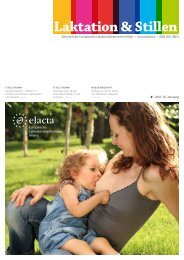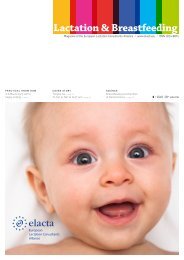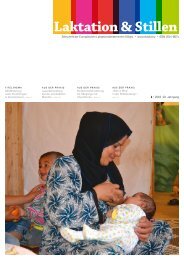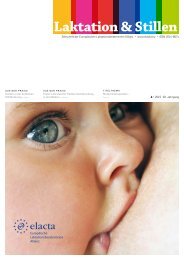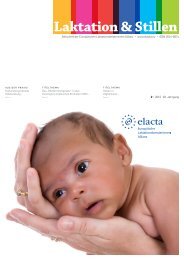8 COVER STORY › › [19] Quigley MA, et al. Breastfeeding is associated with improved child cognitive development: a populationbased cohort study. J Pediatr. 2012, Jan: 160 (1):25-32. Epub 2011 Aug 11 › [20] Oddy, WH, et al. Breastfeeding Duration and Academic Achievement at <strong>10</strong> Years. Pediatrics. 2011 Jan; 127 (1):e137-45. Epub 20<strong>10</strong> Dec 20 › [21] Mortensen EL, Michaelsen KF, Sanders SA, Reinisch JM. The Association between Duration of Breastfeeding and Adult Intelligence. JAMA. 2002; 287:2365-2371 › [22] Saarinen UM, Kahosaari M, Backman A, et al: Prolonged breast-feeding as prophylaxis against disease: prospective follow-up study until 17 years old. Lancet 1995, 346:<strong>10</strong>65 › [23] Abdulmoneim I, Al-Ghamdi S. Relationship between breast-feeding duration and acute respiratory infections in infants. Saudi Med J 2001 22 (4):347-350 › [24] Blaymore Bier J, Oliver T, Ferguson A, Vohr B. Human milk reduces outpatient upper respiratory symptoms in premature infants during their first year of life. J. Perinatol 2002 22 (5):345-359 › [25] Pediatrics <strong>2016</strong>;doi: <strong>10</strong>.1542/ peds.2015-3555] news.mims.com/topic/ prolonged-breastfeeding-reduces-acuteotitis-media-in-infants › [26] Long-term consequences of breastfeeding on cholesterol, obesity, systolic blood pressure and type 2 diabetes: a systematic review and meta-analysis. Horta BL, Loret de Mola C, Victora CG. Acta Paediatr. 2015 Dec; <strong>10</strong>4(467): 30-37 › [27] Breastfeeding and the maternal risk of type 2 diabetes: a systematic review and dose-response meta-analysis of cohort studies. Aune D, Norat T, Rom<strong>und</strong>stad P, and Vatten LJ. Nutr Metab Cardiovasc Dis. 2014 Feb; 24(2): <strong>10</strong>7-15 › [28] Breastfeeding in the 21 st century: epidemiology, mechanisms, and lifelong effect. Victora CG, Bahl R, Barros AJ, et al. Lancet. <strong>2016</strong> Jan 30; 387(<strong>10</strong>017):475-490 › [29] Long-term effects of breastfeeding: A systematic review. Horta BL, Victora CG. World Health Organisation, 2013 › [30] Oberle, D, Toschke, A. M., von Kries R., Koletzko, B, Metabolische Prägung durch frühkindliche Ernährung: Schützt <strong>Stillen</strong> gegen Adipositas? Monatsschrift Kinderheilk<strong>und</strong>e, Dezember 2003, Band 151, Supplement 1, pp S58-S64. › [31] Amitay EL, Keinan-Boker L, Breastfeeding and Childhood Leukemia Incidence: A Meta-Analysis and Systematic Review. JAMA Pediatr. 2015 Jun;169(6):e15<strong>10</strong>25. doi:<strong>10</strong>.<strong>10</strong>01/ jamapediatrics.2015.<strong>10</strong>25. Epub 2015 Jun 1. › [32] Riccardo Davanzo, Giorgio Zauli,, Lorenzo Monasta, Liza Vecchi Brumatti, Maria Valentina Abate, Giovanna Ventura, Erika Rimondi, Paola Secchiero, and Sergio Demarini. Human Colostrum and Breast Milk Contain High Levels of TNF-Related Apoptosis-Inducing Ligand (TRAIL). Journal of Human Lactation. DOI: <strong>10</strong>.1177/089033441244<strong>10</strong>71, http://jhl.sagepub.com/content/ early/2012/02/21/089033441244<strong>10</strong>71 › [33] Exclusive Breastfeeding and Risk of Dental Malocclusion. Karen Glazer Peres, Andreia Morales Cascaes, Marco Aurelio Peres, Flavio Fernando, Demarco, Iná Silva Santos, Alicia Matijasevich and Aluisio J. D. Barros, Pediatrics, originally published online June 15, 2015. DOI: <strong>10</strong>.1542/peds.2014-3276 › [34] Pisacane, AN, Impagliazzo, M, Russo, R. et al. Breastfeeding and multiple sclerosis. British Medical Journal 1994; 308:1411-1412. › [35] Breastfeeding is associated with lower risk for multiple sclerosis. Conradi S, Malzahn U, Paul F, Quill S, Harms L, Then Bergh F, Ditzenbach A, Georgi T, Heuschmann P, Rosche B .Mult Scler. 2012; Sep 4. PMID: 22951352 › [36] Stuebe AM, Rich-Edwards JW, Willett WC, Manson JE, Michels KB Duration of lactation and incidence of type 2 diabetes. JAMA. 2005 Nov 23;29 4(20):2601-<strong>10</strong>. › [37] Zheng T, Duan L, Liu Y, et al. Lactation reduces breast cancer risk in Shadong Province, China. American Journal of Epidemiology 2001; 152 (12):1129-35 › [38] Beral V et al. (Collaborative group on hormonal factors in breast cancer). Breast cancer and breastfeeding: collaborative reanalysis of individual data from 47 epidemiological studies in 30 countries… Lancet 2002; 360: 187-95 › [39] Dada Su, Maria Pasalich, Andy H Lee, and Colin W Binns, Ovarian cancer risk is reduced by prolonged lactation: a casecontrol study in southern China January 2, 2013 Am J Clin Nutr doi: <strong>10</strong>.3945/ ajcn.112.044719. › [40] Rosenblatt KA, Thomas DB. Prolonged lactation and endometrial cancer WHO Collaborative Study of Neoplasia and Steroid Contraceptives. Int J Epidemiol. 1995;24(3):499–503 › [41] Department of Health and Social Security. 1988. Present day practice in infant feeding: third report: report of a Working Party of the Panel on Child Nutrition, Committee on Medical Aspects of Food Policy: Report on Health and Social Subjects 32. Her Majesty's Stationery Office, London › [42] Lawrence RA and Lawrence RM, Breastfeeding: A Guide for the Medical Profession, 7 th Edition 2011:290 › [43] Bradley, J., Baldwin, S., Armstrong, H. 1988. Breastfeeding: a neglected household-level weaning-food resource. In Alnwick, D. Moses, S., Schmidt, OG, eds. Improving young child feeding in eastern and southern Africa: Household-level food technology. International Development Research Centre. Ottawa, Canada IDRC- 265e › [44] Dewey KG. Nutrition, Growth and Complementary Feeding of the Breastfed Infant. Pediatric Clinics of North America. February 2001; 48 (1) › [45] Bradley, J., Baldwin, S., Armstrong, H. 1988 Op. Cit. › [46] Griffin, IJ & Abrams, SA (2001). Iron and breastfeeding. Pediatric Clinics of North America, 48 (2), 401-413 › [47] Perrin MT, Fogleman AD, Newburg DS, Allen JC. A longitudinal study of human milk composition in the second year postpartum: implications for human milk banking. Matern Child Nutr. <strong>2016</strong> Jan 18. doi: <strong>10</strong>.1111/mcn.12239 › [48] Montagne P, Cuillière ML, Molé C, Béné MC, Faure G, Changes in lactoferrin and lysozyme levels in human milk during the first twelve weeks of lactation. Adv Exp Med Biol. 2001; 501:241-7. › [49] Dettwyler, KA Op Cit., S. 47 › [50] Ibid. S. 49 › [51] Ibid. S. 52 › [52] Ibid. S. 55 › [53] Ibid, S. 56 › [54] Markinkovich V: IgA deficiency and allergies. Presentation at the annual meeting of the Human Milk Banking Association of North America, San Jose, CA, September 30, 1988 › [55] Merhave HJ, et al: Treatment of IgA deficiency in liver transplant recipients with human breast milk. Transpl. Int 8:327-9, 1995 › [56] Asquith MT, et al. Clinical uses, collection, and banking of human milk. Clin Perinatol 14:173-85, 1987 › [57] Young VR, Motil KJ, Burke JF. Energy and protein metabolism in relation to requirements of the burned pediatric patient. In: Suskind RM, ed Textbook of Pediatric nutrition. New York: Raven, 1981: 309-40 › [58] Wright HI: The use of donor milk in solid organ transplantation. Presentation at the annual meeting of the Human Milk Banking Association of North America, In., Raleigh, NC, (USA), March 1, 1996. › [59] Wiggins, PK and Arnold, LDW. Clinical Case History: Donor Milk Use for Severe Gastroesophageal Reflux in an Adult. JHL. 1998, Vol 14, Nr 2: 157-159. › [60] www.llli.org/philosophy.html?m=1,0.1 www.elacta.eu Lactation & Breastfeeding 3 • <strong>2016</strong>
HANDOUT www.elacta.eu/en/ downloads.html www.elacta.eu Breastfeeding – as Long as We Wish You have been breastfeeding for 9, 12, 15 months or perhaps for a number of years? You and your child enjoy it? Congratulations! Breastfeeding is part of a special relationship between mother and child. The decision for or against breastfeeding and/or the timing of weaning should, ideally, be determined between the mother and the baby. Perhaps you have already had to defend this or you have already felt uneasy because of some comments. <strong>10</strong> Reflections on Breastfeeding Young Children The world-wide public health 1 recommendation by the WHO (WHA 54.2-Resolution of 2001) reads as follows: “exclusive breastfeeding for six months followed by the introduction of appropriate complementary feeding and continuation of breastfeeding for up to two years of age or beyond” Breastfeeding young children is normal 2 it represents the species-specific standard for Homo sapiens. For 99% of human history, physical closeness and long breastfeeding were “part of the non-negotiable protective and living conditions for young children” (Dr. Herbert Renz-Polster) Mother’s milk remains a valuable food 3 In the second year of life (12 to 23 months), 448 ml of mother’s milk cover 29% of the child’s daily requirements for energy, 43% of the requirements for protein, 36% for energy, 75% for vitamin A, 76% for folic acid, 94% for vitamin B12 and 60% for Vitamin C. Thereby, mother’s milk remains a valuable source of protein and vitamins and provides valuable minerals and long-chain polyunsaturated fatty acids, which are important for the development of the central nervous system. Photo: © Karl Grabherr Mother’s milk supports the young child’s 4 immune response After the 6 th month of life, the amount of immunoactive content (immune globulin, lysozyme and lactoferrin) increases again and may reach concentrations similar to those in colostrum. All of this is a valuable support for the young child’s own immune system, which is still developing.



